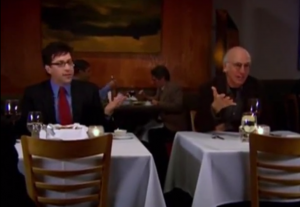Often we are not consciously aware of the prevailing social norms that dominate our culture until they are violated. Many faculty demonstrate the power of social norms to their students with an assignment for them to engage in norm violations – intentionally altering their behavior outside of the classroom to see how others react and how it disrupts social interaction. The risk of this assignment is that students take the norm violation too far, harming others or getting in trouble (try explaining to the Dean that you actually assigned them to do that). Therefore, rules and guidelines must be made clear if this is assigned.
Due to the risks, I tend to enact or discuss examples in class – facing the “wrong” way in a full elevator, acting like a crazed football fan at an opera (including bringing one of those big foam number-one hands), wearing a tuxedo to class, what it means to “act white”, doing gender, etc. One of the most effective and funniest examples I have found that has also received good response from students involves the use of cell phones in public.
A clip from Larry David’s television show Curb Your Enthusiasm clearly demonstrates that the norms around cell phone use in public remain in flux as the technology becomes increasing pervasive in our individual and social lives. The clip shows Larry trying to enjoy a meal alone in restaurant. Someone on a Bluetooth headset next to him interrupts his experience by yapping away. I’ll let you watch the rest.
norms around cell phone use in public remain in flux as the technology becomes increasing pervasive in our individual and social lives. The clip shows Larry trying to enjoy a meal alone in restaurant. Someone on a Bluetooth headset next to him interrupts his experience by yapping away. I’ll let you watch the rest.
It is a short clip, just under 2 minutes, so it does not consume too much of that precious class time. Also, cell phones and their norms of use are an issue that seems easy for students to relate to and provide additional examples or personal anecdotes. “What age is it appropriate for children to own a cell phone? When is it appropriate to answer and talk on your phone? When is it not? Why do we feel the need to answer the phone every time it rings?” You can always come back to this example later in the semester when, inevitably, one of your students’ cell phones will ring during class, or worse yours! “Woops!”
When is it not? Why do we feel the need to answer the phone every time it rings?” You can always come back to this example later in the semester when, inevitably, one of your students’ cell phones will ring during class, or worse yours! “Woops!”
While not of great social significance, this norm violation is a good way to begin the discussion, generate laughter (which refreshes students’ attention), and demonstrate the social processes of norm enforcement. From here, you can make the leap to the power of social norms of more consequence.
*A note of warning, if you are not comfortable with cussing making an occasional appearance in your classroom, you will not want to use this f#@king clip.
A few related pieces of academic research (click on the title to link to the piece):
“Making Sociology Relevant: The Assignment and Application of Breaching Experiments” by Adam Rafalovich
“Random Acts of Kindness: A Teaching Tool for Positive Deviance” by Angela Lewellyn Jones
Constructions of Deviance: Social Power, Context, and Interaction, edited by Patricia Adler and Peter Adler

Comments 1
TANIA SALAZAR — April 25, 2018
I feel like an appropriate age to have a cell phone is 14 because that's when children start to go out more. when children go out there are many dangerous things and it is important for them to communicate for help when needed. I think that now in the modern world, kids are expecting to get a phone because all these other kids are getting phones are younger ages.
It is appropriate to answer the phone if no one is having a conversation with another person. Also we feel the need to answer the phone every time it rings because we know there is someone on the other end of the line who is trying to communicate. I think people have got conditioned to answer or reach out for their phone anytime it rings because we know someone is expecting us to answer fast.
Also, humans have become conditioned to rely on phones and technology based on how our world has evolved into doing all of our work and communication through computers and phones. I do not agree with children getting phones at a really really young age because it can negatively affect on the kids. Some effects can be that they will depend on technology.